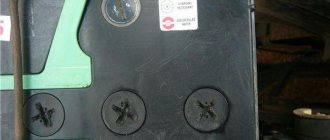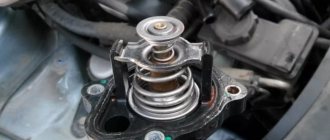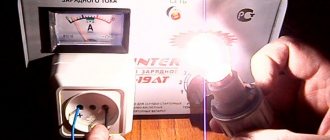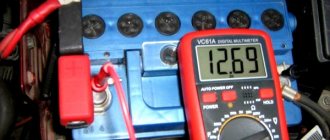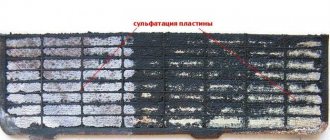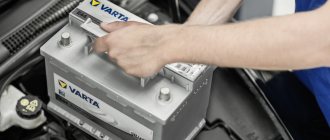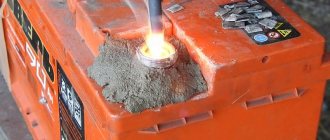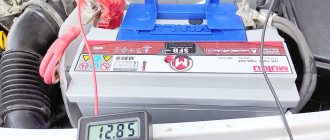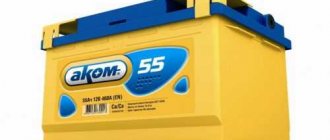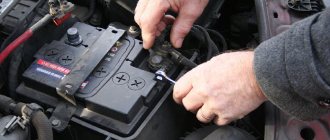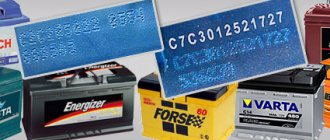The purpose of the battery is to start the engine starter and maintain power to consumers in the electrical on-board network, together with the generator. If the car battery does not perform its functions, restoration or replacement is required. Knowing the principle of operation of the battery and its design, you can try to restore the battery’s functionality with your own hands.
Types of battery malfunctions
The first sign of a battery failure is not always a loss of voltage. You may find that the device body is cracked, or the terminals are covered with salt deposits. Restoring the integrity of the case and cleaning the battery terminals with your own hands refers to the elimination of external damage.
Internal malfunctions of the car battery require restoration:
- capacity of a deeply discharged battery;
- cleaning lead sulfate deposits on cathodes;
- a short circuit between differently charged plates, leading to boiling off of the electrolyte and heating of the cans;
- shedding of the active mass from the plates, leading to a short circuit.
Restoring a car battery with your own hands is impossible if the case and plates are deformed due to deep freezing. If the lead plates are destroyed or the case is swollen, the battery is disposed of.
Reasons for battery failure
The main reasons for battery failure are as follows:
- damage to the battery case and plates for various reasons;
- short circuit of battery plates of different polarities for various reasons;
- rupture of the internal battery circuit;
- plate sulfation.
It is worth immediately noting that most of these breakdowns on modern batteries cannot be corrected with your own hands or in services. With some types of breakdowns, the battery can be returned under warranty, if it is still valid. In other cases, repairing a car battery becomes very problematic. To avoid it, it is better to service your car battery on time. Now, let's take a closer look at the main reasons for battery failure.
Damage to the battery case and plates
One of the main causes of such damage is mechanical impact on the battery. This could be a strong blow, a fall, and so on. In addition, freezing of the electrolyte in the battery can lead to destruction of the case and damage to the plates (link to material). As expansion occurs when freezing, it causes cracks in the housing and warping of the plates.
In case of mechanical damage to the housing, if the plates are not affected, repair is possible. It boils down to the fact that you will need to repair the polypropylene body. This repair can be done by yourself. If the destruction of the housing and plates was caused by freezing of the electrolyte, then it is necessary to evaluate the consequences in each specific case. If, as a result of freezing, the plates did not warp and no short circuit occurred, then you got off lightly. And if a short circuit occurs in one or more banks, then the battery can be sent for recycling and purchased a new one. Today on forums you can find questions about how to disassemble a car battery. Modern low-maintenance or maintenance-free car batteries cannot be disassembled. More precisely, it can be disassembled, but this is an irreversible process that destroys the battery. Only serviceable old-style batteries, which are no longer available, can be disassembled for repair and replacement of cans.
Closing the plates
Short circuit of the plates can be caused by the following reasons:
- manufacturing defects;
- mechanical deformation or freezing of the electrolyte;
- shedding of the active mass of the electrodes;
- separator damage.
In case of manufacturing defects, there is a warranty for car batteries. This is definitely a warranty case, which usually manifests itself in the first six months of battery operation. Everything else is not covered by the warranty and in most cases cannot be repaired.
Open battery internal circuit
If this happened during normal operation of the battery, then the battery can be returned under warranty. At the same time, it should not have any damage (traces of impacts, cracks, melting, etc.). If the battery is used correctly, then such a malfunction in most cases is a manufacturing defect. Repairing this fault is either impossible or very problematic. So, in this case, you will have to exchange the battery under warranty or buy a new one.
Sulfation of plates
Plate sulfation is the process of deposition of lead sulfate (PbSO4) on the surface of positive and negative electrodes. As this substance accumulates, it clogs the surface of the active mass of the plates, which leads to a significant decrease in battery capacity.
Lead sulfate is formed during battery discharge and dissolves during charging, but the process is not completed. As a result, part of it remains on the electrodes in the form of a white coating.
This type of battery failure can be corrected. But it’s worth saying right away that sulfation in most cases is successfully “treated” in the early stages. If the battery has already worked for several years and has lost a significant part of its capacity, then it is easier to buy a new one. In such advanced cases, in addition to sulfation, there is also corrosion of the plates and connecting bridges, significant shedding of the active mass, and so on. By restoring such a battery, you will simply waste time.
Do-it-yourself car battery restoration
If, due to an oversight or due to a faulty generator, an almost new car battery is completely discharged, the owners try to restore it themselves. This is possible, but there are more problems when repairing a maintenance-free battery.
Regardless of what operation is performed, you need to remember about protection. The electrolyte is a concentrated solution of sulfuric acid that reacts well with the skin, charring the skin. When cleaning the terminals, you should use rubber gloves; all measurements of the level and density of electrolyte in open jars should be carried out wearing safety glasses.
Do you suspect microcracks in the case? Wet the surface and place litmus paper. If it turns red, look for a leak. But dust when cleaning terminals is also soluble and gives an acidic reaction. Take this into account.
Any washing of the body and draining of the electrolyte can be carried out in enamel or plastic containers. Remember, when diluted with water, the temperature of the solution increases. You can neutralize spilled electrolyte with baking soda.
We invite you to watch the video on how to restore a car battery with your own hands.
What tools are needed for opening
To gain access to the filler holes, even if they are filled at the factory to the surface level of the case, you must remove the cover from the battery. How to open the battery cover? If it is on the grooves, then carefully unclip the fasteners and remove the element. You may need a flathead screwdriver.
A hot pressed part will not come off easily. During its dismantling, there is a high probability of the part breaking. Therefore, we do not recommend removing this type of element. However, if you wish, you can try to break the integrity of the part using an awl, screwdriver or drill. You will not remove the cover completely, but you will be able to make holes for further operations.
Restoring a car battery after deep discharge
The battery does not produce electrical energy, but stores it converted into chemical energy. Voltage is the potential difference between the two terminals of an element. It should be equal to 2.1 V when fully charged. During charging, positive particles collect on the anode, absorbing electrical energy. When discharged, the ions move from the anode to the cathode and release energy in the form of a pulse to the consumer network.
The conductor is an electrolyte - a solution of sulfuric acid of standard density. During the discharge period, small PbSO4 crystals appear on the surface of the plates. But a deep discharge leads to the formation of large insoluble crystals. This means that the electrolyte becomes depleted, becomes weaker and is not able to create the required energy capacity. The formation of an insoluble precipitate on the plates makes it difficult for current to pass through, and resistance increases. The battery is dead. Restoring the battery charge depends on the destruction of the zinc sulfate deposit.
Another reason for loss of capacity may be a short circuit in one or more elements. Negative and positive plates are separated by separators. But a shock, constant shaking, or poor fastening of the housing in the socket can cause the plates to shift and come into contact. A sign will be heating of the case, loss of total voltage by 2.1 V (non-functional bank). Restoring battery capacity during a short circuit requires replacing the battery or applying a pulse current of 100 A.
Is it possible to add distilled water?
You can pour distillate into the battery , and here's why. In cans, lead reacts with sulfuric acid.
However, the latter is not presented in its pure 100% form, but is diluted to 35%. This solution is called an electrolyte.
The remaining 65% is taken up by water. Moreover, it is there in a fairly pure, that is, distilled form. That is why it can only be filled into the battery in this modification.
If the battery is filled with ordinary H2O - from a tap, stream or mineral water, a salt coating will form on the plates , since unpurified water is a solution of various salts. During electrochemical interactions, they will settle on the surface of the plates and will soon lead to damage to the device.
Restoring the capacity of a car battery
Even if there was no deep discharge, but the battery is operating in a half-discharged state, sulfation of the plates will inevitably occur. The thicker the sediment, the lower the electrolyte concentration and battery capacity.
Schemes for returning battery capacity involve restoring the density of the electrolyte and the battery’s ability to accept a charge.
- Dismantling the plates and their mechanical cleaning is used if the other method is only disposal. Holes are cut in the housing cover and the plates are removed. The cavities and plates are washed with distilled water. The tightness of the structure is restored, electrolyte is poured in, and charging is performed. But since the plates are fragile, restoring the battery in this way is a jeweler’s work.
- Chemical dissolution of crystals can save a completely dead battery. The active substance is a solution of Trilon B. Discharge the battery, drain the electrolyte, and rinse the insides with distilled water. Pour 2% Trilon B solution and 5% ammonia for the entire volume into clean jars. Within an hour, boiling and gas formation will occur. The solution may need to be refilled more than once if the dissolution reaction of the sediment continues. After draining the solution, rinse with distilled water and add fresh electrolyte. Charge.
How to do it at home?
distilled water yourself using several simple methods:
- Distillation or evaporation.
- Freezing.
In the first case, you will need a special device - a distiller. As an alternative, you can use a moonshine still.
In the absence of both , a very simple method is used:
A large saucepan is placed on the stove.- It is closed from the outside with a lid, and a container (smaller pan) is placed inside.
- To prevent it from floating, a weight should be placed on the bottom (for example, a fishing sinker).
- The pan is filled with water to the middle of the walls of the inner container (water should not get into it when boiling).
- After boiling, the water will begin to evaporate, and condensation from the lid will drip into the container.
The liquid in the container will be distilled water.
By freezing it is even easier to prepare the distillate . To do this, you need to take a 1.5-2 liter plastic bottle, fill it with water and place it in the freezer (or outside if it happens in winter).
After half of its volume freezes, the liquid part should be drained and the frozen part should be melted - this will be distilled water.
For detailed instructions on how to make distilled water with your own hands, read this article.
Charger for restoring car batteries
- Dissolution of crystals at an early stage using the control-training cycle method. You will need a charger, an ammeter and a voltmeter, an energy consumer. The principle of restoring the density of a car battery is to use several charging cycles with a complete discharge of the battery. The operation is done by hand but requires a lot of time.
Charging is carried out with a current of 0.1 of the original battery capacity. The density of the electrolyte in each jar is measured, brought to normal, and charging is carried out for another half hour for mixing. Then a 70 V incandescent lamp is connected as a current consumer. At 10.2 V, the battery is considered discharged. The discharge time determines the remaining battery capacity. A new battery takes 10 hours to discharge.
The cycle is repeated several times, the sulfate crystals dissolve, the resistance drops, and the battery discharge time increases. The process of cleaning the plates from sediment must be continuous. This is the best way to restore an old or unmaintained car battery.
- You can dissolve sulfate stone without chemicals using only distilled water. The battery filled with water is charged at a voltage of 14 V. A low boil in the jars is maintained by voltage regulation. During the process, the density of the liquid changes - the precipitate dissolves. The water is changed several times, the process may take a month. After cleaning the plates by dissolution, the cavities are washed and filled with electrolyte of the required density.
- When no methods help restore the car battery, use reversal. The method will help if the battery is of high quality, the electrolyte is transparent, only deposits on the plates are visible. Sulfates are deposited on the anodes. If a negative pressure is applied to the plate, the sediment will be destroyed. We connect a completely discharged battery to a reverse current of 6 A, reduce it to 2A, add resistance to reduce the heating of the battery case. Recovery is accompanied by boiling of the cans. Afterwards, the device should be reversed. The capacity will return or the battery will be completely destroyed.
- There is a special charger for car batteries with a pulse mode and desulfation function. Capacity restoration scheme:
charging at low current for 10 minutes;
discharge under load 1 minute.
The cost of the device is commensurate with the price of a good battery. A conventional charger is most often used to restore and charge car batteries.
Safety precautions
Attention! A sealed battery contains an acid solution. Contact with unprotected skin may cause burns.
- We strongly recommend using protective equipment when disassembling the power supply. It is strictly forbidden to turn over or shake the jars. This may cause a short circuit.
- If the battery cover is secured with fasteners, be careful not to break them. In the event of a breakdown, the part will have to be glued, and this does not guarantee safe operation of the power source.
- If you want to split the battery using a tool, choose special products that will help protect your eyes from splinters.
Can we safely say that a maintenance-free battery can be made into a serviceable one? Of course, a closed battery can be remade! If the purpose of opening the battery is to extract lead for fishing or hunting, then by observing a number of precautions, you can easily do it with just a hammer.
If the battery is shorted
The first sign of failure of the can will be a drop in voltage to 10.5 V. The second is boiling of the battery and sulfation of the plates. A faulty element can be detected by the density of the electrolyte.
You can empty the jar of electrolyte, rinse and remove the plates from it. After inspection and repair of damage, the circuit is restored and sealed. Sometimes the bank is replaced with a similar one from a non-working battery. The element is put in place, the connection with the car battery terminal is restored.
A shorted battery bank is the reason for its disposal. Sometimes a risky method is used to influence the problem area with a pulse with a current strength of 100 A for 1-2 seconds. The junction of the plates should melt - point contact and high resistance. However, it is worth the risk if the battery is being prepared for write-off.
How to open a maintenance-free battery
There are not many ways to open a closed-type power source, and they depend on the intended purpose. If you need lead (for hunting or fishing), then you don’t have to worry about opening the battery and just break its case.
Attention! The acid solution must be drained first!
In order to extend the life of the battery, you need to make holes that will give access to the banks.
- Remove the stickers from the surface of the battery.
- Carefully inspect the body. Since the sealed lead-acid battery was filled at the factory, stamping of the plugs remained.
- Take an awl, screwdriver or drill and carefully make holes in place of the bays.
This simple procedure requires care, but allows you not to purchase a new power source, but to restore the functionality of the existing one.
Signs of wear
To understand that the battery will soon fail, you need to have some information - find out the main signs. Without the necessary knowledge, restoring car batteries will be difficult. You will need to carefully monitor your car. Only in this case will it be possible to take the necessary repair measures, in particular the battery, in a timely manner.
There are several main signs:
- If the battery quickly loses its charge, then you need to worry. This is the first sign of a decrease in the quality of the electrolyte poured inside.
- Another sure sign of a battery malfunction is very fast charging through a special device. The reason for this will be sulfation, which has already begun.
- The electrolyte has darkened. If the substance begins to darken, then it is necessary to immediately begin restoring the battery, because this is one of the main signs that the carbon plates are beginning to crumble and deteriorate.
- If individual sections of the battery heat up or the electrolyte boils, this is due to the plates being shorted or damaged. The main reason for this malfunction is that the car sits idle for a long time in extreme cold. The plates may freeze and the body of the device may become covered with ice. As a result, a short circuit will appear, which, in turn, will lead to very rapid boiling when charging the electrolyte. This malfunction is already very serious, and in most cases it will not be possible to resurrect the device.
The battery can be restored in almost all cases if it is completely neglected. The operation can be quite expensive, but the money will be spent much less than when purchasing a new unit.
You need to be careful when using the battery and immediately notice various problems. The life expectancy of the battery will depend on this. Before you begin to directly restore the car, you need to find out which parts of the battery are generally subject to resuscitation.
Electrolyte density
The electrolyte is poured into the battery .
Usually this substance is a kind of cocktail of acid and water. If the battery is nickel-cadmium or nickel-iron, then in this case an alkaline electrolyte is poured inside. We recommend: Types of Japanese car batteries FB Before you start repairing the battery, you need to know exactly the density of the electrolyte. To do this, use a device called a hydrometer. You don’t have to spend a lot of money to buy it; it is sold in absolutely any auto parts store. You can also use a voltmeter to measure the density of the acid solution. The equipment must be turned off to the vehicle terminals.
When turned off, the numbers should be approximately 11.9-12.5 V. After this, turn on the car, pick up 2500 revolutions and take the measurement again. If the voltage is 13.9-14.4 volts, then the density is within normal limits. In this case, the old battery only needs to be recharged. But if the indicators are too low, a restoration will be required.
Several ways to perform resuscitation:
- Using a battery charger and bringing the charge to 100%. You can't lose charge.
- Complete replacement of the battery solution with a new one.
- Use of high-density electrolyte.
- Adding only sulfuric acid.
- Adding only water.
Before restoring the acid solution, it is worth trying to simply recharge the equipment. Sometimes it happens that after such a simple procedure all problems disappear.
If problems with the electrolyte appear after charging, then it is necessary to change the density of the solution in the battery.
Under no circumstances should water be poured into sulfuric acid . It is very important. Otherwise, you can get very serious skin damage in the form of burns. The water will boil and splash out in different directions. Restoring a car battery must be done carefully.
Destruction and short circuits of plates
If the plates on the battery have broken down or are just beginning to break down, then it is necessary to immediately take restoration measures. If the battery is significantly damaged, then it will no longer be possible to restore its parts.
That is why before resuscitation, you need to make sure that this is not a useless exercise. The process of destruction can only be stopped if it has just begun. There is no point in reviving a fairly battered device.
If you find signs of destruction, you should immediately wash the jars:
- First, you need to completely discharge the device by connecting any load to the battery. For this purpose, a regular light bulb is usually used.
- All damaged solution is removed from the jars. To do this, use a rubber bulb. The solution is placed in a glass container that has been previously prepared.
- The jars are washed with distilled water until completely clean. When cleaning the battery, it is necessary to constantly turn it over and shake it.
- If there is a lot of dirt inside, and coal crumbs are still pouring out, then the process is already irreversible, since it has gone far. In this case, the battery can no longer be restored.
- When complete cleanliness has been achieved, a new solution must be placed in the jar. Before this, the density of the substance must be checked.
- The battery is charged so that the previous voltage returns to the desired level.
When the cleaning operation is completed and the device is fully charged, you need to check the electrolyte and its density again. If necessary, the indicators will have to be brought back to normal.
Diagnostics of sulfation
Sulfation is one of the most common battery problems. Under normal operating conditions, certain processes occur in the battery during discharging and charging. But when the car starts infrequently, the processes will be disrupted.
We recommend: Which battery is better: serviced or maintenance-free
Lead sulfate crystals may appear on the plates. They are difficult to remove and can lead to the following consequences:
- Battery capacity decreases.
- Internal resistance increases.
- The volume of the plates increases.
In most cases, sulfation begins to appear if the car sits for a long time without use, overheats, or is exposed to critical current conditions. You can understand that sulfation has begun by seeing a drop in charge.
To determine this indicator, you need to use a tester. If a defect is found, you need to think about ways to restore the battery in the near future. You need to act quickly while the device still has the opportunity to be restored. To restore it, it is necessary to use a special electrolyte additive. A desulfator is usually used to dissolve the crystals that have formed. These were the main problems. After studying them, you can learn how to reanimate a car battery at home.
Charging after topping up
After the electrolyte level is brought to the desired mark, the battery should be left for 3-4 hours for better mixing of the components.
Then you can put it on charge, following the algorithm:
- With the covers open, connect the charger to the terminals, observing the polarity, and plug it into the mains.
- The current strength should not exceed more than 10% of the battery capacity.
- If the electrolyte begins to boil before the desired density is established, you should turn off the charger and allow it to cool. You can also reduce the current.
- Charging is considered complete when the density value reaches the specified value when heated to 25-300C.
- After completing the procedure, after half an hour, bring the electrolyte level to normal with distilled water, close the plugs and install for operation.
Maintenance-free batteries are charged strictly according to the set voltage value of the charger. Check the outgoing voltage with a voltmeter.
Read a detailed article about charging the battery after topping up here.
How to determine that the battery is asking for fluid to be filled?
There are several signs to make sure that distillate needs to be added to the battery:
A visual check showed the fluid level to be below the set level, which is especially important after long trips.- Strong heating of the battery case during operation.
- Presence of electrolyte leaks on the outside of the battery.
- Steam comes out of the filling holes.
The car owner must take into account the type of battery design. So, if this is a serviced model, the process of water loss due to evaporation occurs much faster than in unserviced copies.
As a rule, the latter, due to their sealed cast structure, do not require periodic refilling throughout their entire service life.
Even more information about when to fill the battery with distillate can be found here.
What can be replaced?
If distilled water is not available, and the battery is needed in the near future, you can use the following liquids:
- Water formed when freezer ice melts.
- Condensation from climate control systems.
- Homemade option.
When choosing a source as a replacement, it is important to pay attention to its purity.
For example, snow and rain are unlikely to correspond to the level of purification of technical distillate. Also, do not take boiled water.
Repair for sulfation of lead plates
Sulfation of the plates is the coating of them with a sediment in the form of a white coating, which interferes with the passage of current inside the battery.
To repair batteries when the plates are sulfated, in other words, desulfated the battery, you should replace the old electrolyte with slightly heated distilled water. This method is effective if the plaque on the plates is not yet so strong. This can be determined by objectively examining the inside of the battery after the old electrolyte has been drained.
Distilled water will act as a solvent for salts in the battery, which will simply turn into a solution. The water will gradually transform into the state of the electrolyte needed by the battery, and U, as the process progresses, should reach 10 V.
How to determine the electrolyte level?
If the case is transparent, it is easy to determine the actual electrolyte level. Upon visual inspection, it becomes clear in what position the upper fluid line is located relative to the special factory mark.
Another thing is a battery with opaque walls. In this case, you will need a piece of glass tube about 5 mm in diameter.
Checking with it comes down to the following algorithm of actions:
- The filling plug is removed.
- The tube is lowered inside until it stops at the bottom.
- After which its outer edge is closed with a finger.
- Next, it is removed along with the accumulated electrolyte.
- The level is determined by special divisions (min and max).
- If necessary, fill the electrolyte and re-measure to the required level.
You can fill the battery with water, as well as start using it after refueling, only after several hours of the car being idle with the engine turned off. Otherwise, the electrolyte will boil.
